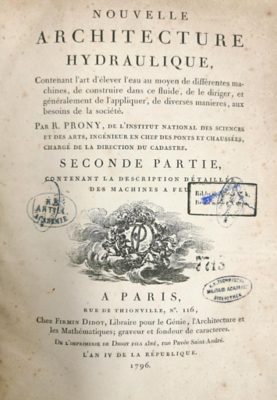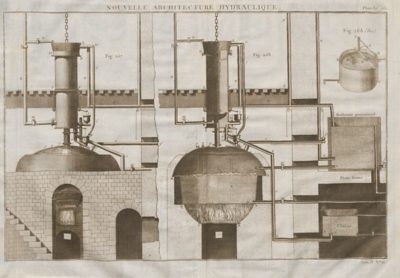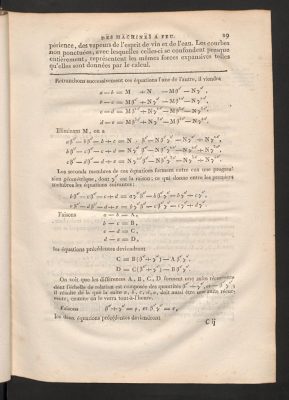Gaspard de Prony 'Nouvelle architecture hydraulique' (Paris: Didot, 1790-1796).
Acquired in 2022
Acquired in 2022
De Pronys "Nouvelle Architecture Hydraulique" is a comprehensive treatise in two volumes that brought a groundbreaking standard of approach to hydraulic engineering and architecture. This opus still marked a gap in our rare book collection, which is why the Iron Library placed a search request with various antiquarian booksellers in 2016. After six years of waiting, our patience was rewarded with two extremely well-preserved first editions.
The author, Gaspard de Prony, was a gifted mathematician and engineer who had already secured himself a sizeable reputation before the outbreak of the French Revolution. It was amidst the tumult of 1790 that the first of the two volumes was published. The book, along with his record of civic engineering works, sealed his status as one of the revolutionary state's great technological modernizers and thinkers. Indeed, his repute was such that before commissioning any great engineering project, Napoleon Bonaparte is reported to have always asked, "And what does de Prony think?"
De Prony's eminence becomes apparent with even the lightest perusal of the volumes of "Nouvelle architecture hydraulique". Away from the innovators, the general field of engineering in his time was blighted by solutions produced out of habit and tradition, more often improved by trial and error, rather than a full understanding of the mechanics of the problems being dealt with. De Prony, however, was deeply rational, thorough and fundamental in his approach. He placed mathematics at the center of all considerations, beginning from a point of theory, defining the problem at an essential level, before shaping the solution around the results of numerous mechanical calculations.
The design concepts and apparatus that feature are not always his own but those that he had evaluated and deemed worthy of promotion. In such a way, he made his books indispensable, as they offered a practical synthesis of theories and concepts otherwise scattered throughout many other publications. The books list the tolerances of construction materials, such as types of stone, alongside mechanical and engineering principles based on Joseph-Louis Lagrange's analysis of statics, dynamics, and hydrodynamics. There is a chapter dedicated to machines and motion based upon works by Charles-Augustin de Coulomb and Johann Heinrich Lambert.
Steam engines are given particular attention and feature among the 53 large engravings detailing complete technical apparatus that were published in the second volume in 1796. Here de Prony made particularly original contributions to steam engine design, including a calculus-based technique for evaluating the expansive force of an elastic fluid that has been put in motion. Such calculations allowed for the better comprehension of the power of steam engines, and were essential for devising the more powerful engine designs that were to drive mechanization in the following century.
Together both volumes map out de Prony's own revolution, in which he encouraged a culture of innovation that combined high science with an innate pragmatism to reshape the process of producing practical engineered solutions. In a way, his method was a precursor to design thinking. They cover a very important gap in the Iron Library's collection of works charting major milestones in the history and evolution of hydraulic engineering concepts, from Agricola and Ramelli, through to Jakob Leupold, Bernard Forest de Bélidor and Caspar Walter.
 The cover page, stamped by the library seal of the Austrian Imperial Technical Military Academy
The cover page, stamped by the library seal of the Austrian Imperial Technical Military Academy
 Cut-away engraving of a design for a high pressure boiler
Cut-away engraving of a design for a high pressure boiler
 A steam engine developed from the type created by Watt
A steam engine developed from the type created by Watt
 Model calculations for expansive pressures
Model calculations for expansive pressures
 The volumes on the shelf in the Ernst Müller Room
The volumes on the shelf in the Ernst Müller Room